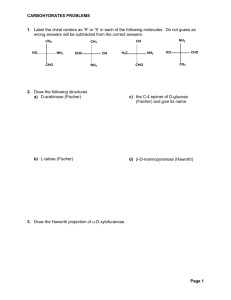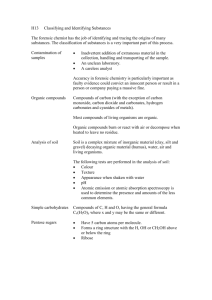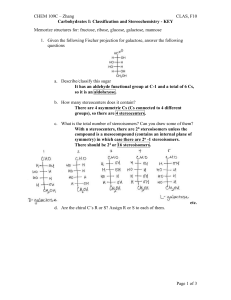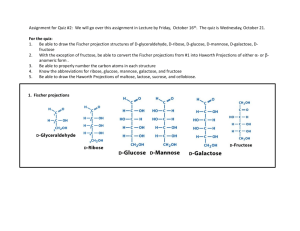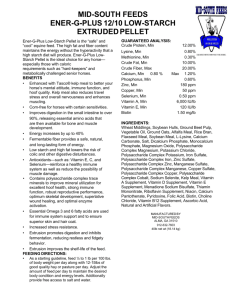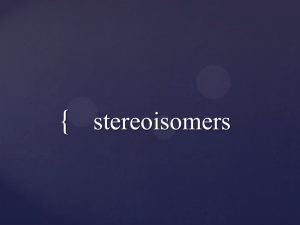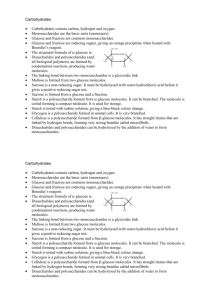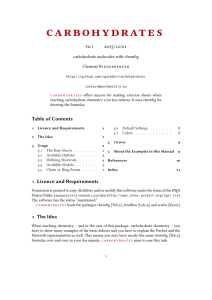Homework - Chapter 20 Chem 2320
advertisement
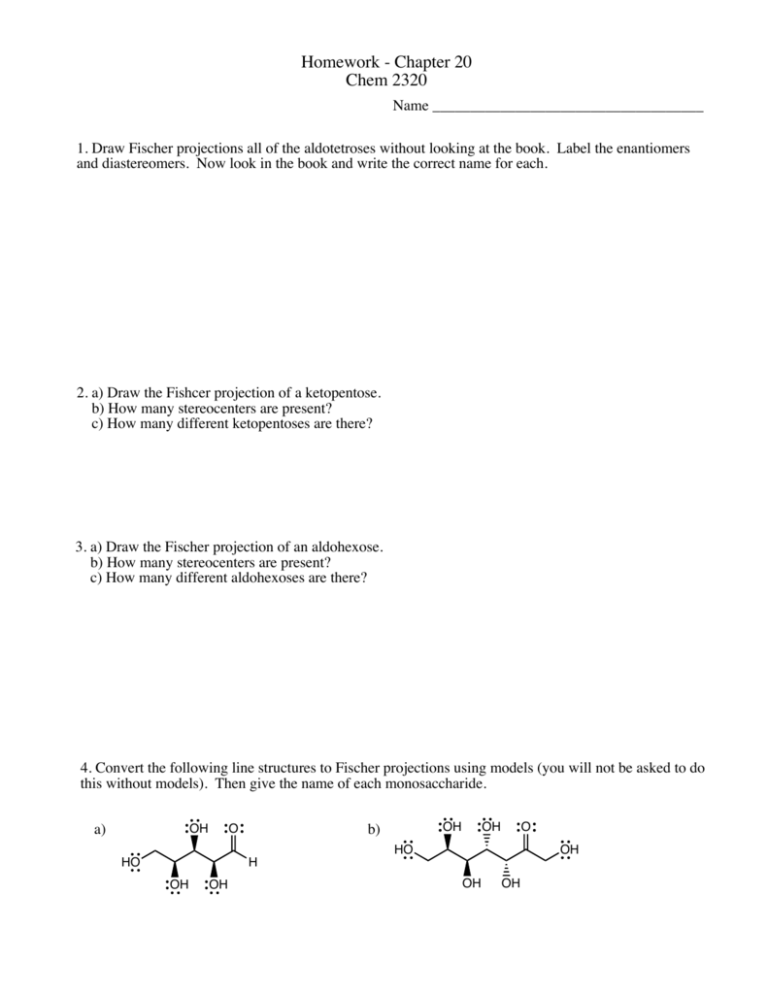
Homework - Chapter 20 Chem 2320 Name ____________________________________ 1. Draw Fischer projections all of the aldotetroses without looking at the book. Label the enantiomers and diastereomers. Now look in the book and write the correct name for each. 2. a) Draw the Fishcer projection of a ketopentose. b) How many stereocenters are present? c) How many different ketopentoses are there? 3. a) Draw the Fischer projection of an aldohexose. b) How many stereocenters are present? c) How many different aldohexoses are there? 4. Convert the following line structures to Fischer projections using models (you will not be asked to do this without models). Then give the name of each monosaccharide. OH a) O HO H OH OH OH b) OH O HO OH OH OH HW Ch 20 p 2 5. Draw the Fischer projections of the monosaccharides described, and give the names for the b - f. b) the enantiomer of D-idose a) D-idose d) the C3 epimer of D-idose e) the C4 epimer of D-idose c) the C2 epimer of D-idose f) the C5 epimer of D-idose 5. Draw the mechanism by which D-mannose forms a pyranose hemiacetal under acid catalysis. Draw the product in the Haworth projection. H O HO H HO H H OH H OH H+ CH2OH 6. Draw the mechanism by which D-mannose forms a furanose hemiacetal under acid catalysis. Draw the product in the Haworth projection. H O HO H HO H H OH H OH CH2OH H+ HW Ch 20 p 3 7. Draw the following using Haworth projections. a) !-D-mannopyranose d) !-L-ribofuranose b) "-D-galactopyranose c) "-D-allofuranose e) !-D-gulopyranose f) "-L-talofuranose 8. Give the product of D-altrose (or other compound as specified) with each of the following: a) nitric acid d) the product of c with hydrogen peroxide and iron (III) sulfate b) sodium borohydride e) hydrogen, nickel c) bromine in water f) acid, phenylhydrazine HW Ch 20 p 4 i) the product of h with H3O+ g) HCN and KCN h) the product of g with hydrogen and barium sulfate j) NaOH k) another product from reaction with NaOH 9. Give the product of !-D-galactopyranose (or other compound as specified) with the following reagents: a) draw starting material b) silver oxide and methyl iodide c) product of b with H3O+ d) acetic anhydride, pyridine e) CH3CH2OH, TsOH f) product of e with HIO4 g) product of f with H3O+ HW Ch 20 p 5 10. What monosaccharide will give the same osazone as: a) D-altrose b) D-idose c) L-galactose 11. What 2 monosaccharides will give the following products after Ruff degradation? a) D-erythrose b) D-xylose c) L-ribose 12. What sugar could undergo Kiliani-Fischer synthesis to form: a) D-galactose + D-talose b) D-xylose + D-lyxose c) L-glucose + L-mannose 13. Answer the following questions. a) What is the name of the disaccharide found in milk? b) What polysaccharide makes up the exoskeleton of insects? c) What disaccharide is found in sugar cane and sugar beets? d) What polysaccharide is found in wood, cotton, paper, and rayon? e) What polysaccharide is soluble in water and can be used as humans as a source of glucose? HW Ch 20 p 6 f) What polysaccharide is used as glucose storage by human beings? g) What enzyme do lactose intolerant people lack? h) What type of linkage can be broken by termites and cows but not by humans? i) If an infant has galactosemia, what does the enzylme they are missing do? j) Which polysaccharide is rigid and stable and not water soluble because of hydrogen bonding between OH groups? k) Which polysaccharide comes from plants and contains 1,6' linkages which form branches? l) How does chitin differ from cellulose? m) Why does acid make holes in jeans? n) What two polysaccharides are highly branched? o) Why do plants produce starch? p) Describe the difference between the linkage between glucose molecules in cellulose and amylose? q) Why wouldn't the starch-iodine test work with cellulose? (2 reasons) r) What enzyme is responsible for hydrolyzing starch molecules to glucose? s) Why is sucrose a better choice for making jam than glucose or fructose?
